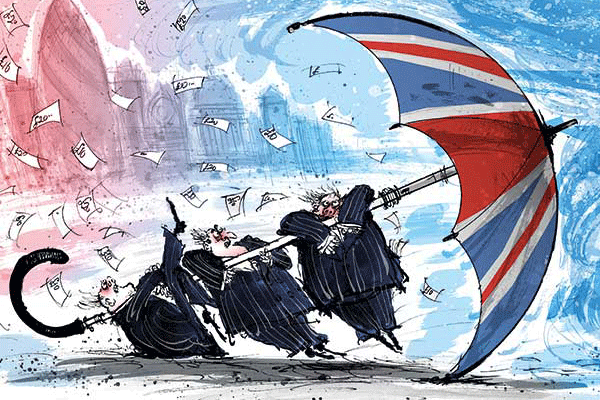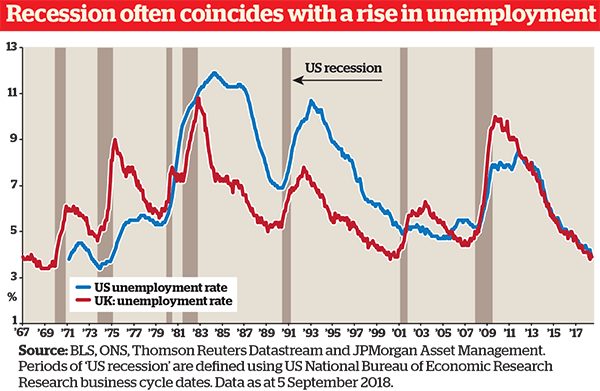How to shock-proof your portfolio as the economy cools
Investors sensing a downturn must be careful where they seek safety, warns Karen Ward.
27th September 2018 11:38
Investors sensing a downturn must be careful where they seek safety, warns Karen Ward.

The UK has had a good summer. In economic terms, so has the global economy, which has enjoyed strong growth for nearly 10 years. However, as the nights draw in and the leaves start to fall, investors know that just as the seasons inevitably change, economic expansions end. There is nothing particularly troubling in the latest economic data, but some investors are considering how to prepare for gloomier days.
So why do periods of economic expansion end? While no two recessions are entirely comparable, the playbook often runs in the following order: unemployment falls, emboldened workers ask for higher pay, central banks hike interest rates to stem inflationary pressure, and higher wages and rising interest costs squeeze corporate profits, which leads to job cuts. Fearful of losing work, consumers rein in spending, demand falls and recession takes hold.
Confounding variables
Sounds simple, so why are economists notoriously bad at forecasting recessions? The reason is that economic relationships change. Workers may not ask for more pay, central banks may not slam on the brakes by raising interest rates, and households and business may keep spending despite higher interest rates if ‘animal spirits’ are running high. All these factors will extend the cycle. And of course the playbook might change fundamentally in the event of a financial crisis or geopolitical shock.
It’s not clear where we sit in the current global cycle. The economic expansion is most advanced in the US. The unemployment rate – at almost a 50-year low – suggests we are well into the autumnal phase. However, wage growth remains subdued, so there has not yet been a squeeze on corporate profits. Even stripping out the effect of US president Donald Trump’s corporate tax reduction, US corporate profits rose by almost 8 per cent in the second quarter – a very healthy rate.
However, the US Federal Reserve, the central bank of the US, is slowly lifting interest rates. This will be an increasing burden, particularly for companies that have been overly tempted by the low interest rates on offer in recent years and have accumulated a lot of debt. Higher interest rates may well start to bite just when the almighty fiscal stimulus provided by the Fed begins to fade.
In the UK, the recovery was more aligned to the US revival before uncertainty surrounding the Brexit referendum slowed the pace of activity. Despite the fact that UK unemployment is at a multi-decade low, the Bank of England is, for now, more hesitant than the Fed about raising interest rates to slow things down.
In contrast, the European economic cycle is less advanced. Indeed, it could be argued that the European cycle is in a phase closer to spring in economic terms. Having double-dipped with the sovereign crisis, unemployment is still relatively high in much of the region. There is ample spare capacity to fuel future growth. As a result, the European Central Bank has little intention of lifting interest rates until at least the summer of 2019.
These economic cycles aren’t aligned, but a downturn in the US is likely to filter through into a global slowdown, as it has in the past.

Correction conundrum
It is hard to speak with any conviction about the likely start date of the next recession, but we can say with some confidence that the next stock market contraction is likely to be less severe than the corrections of almost 50 per cent seen in the two most recent recessions. There has been a tremendous regulatory drive to reduce the likelihood of another global financial crisis. The financial system is better capitalised and more transparent, which should reduce the risk of contagion.
Moreover, stock market expectations of future growth are considerably more modest than they were ahead of the 2001 dotcom bust. Then, the S&P 500 tech sector peaked with a price-to-earnings (p/e) ratio of 48 times, and the stock market as a whole was on a multiple of 24 times. While some tech firms today have very high valuations, the tech sector as a whole now has a p/e ratio of 19 times and the S&P 500 index multiple is broadly in line with its average over the past 25 years.
With the US economy still booming and valuations looking reasonable, it isn’t obvious that any dramatic rejigging of investment portfolios is required. Investors looking to time the market have rarely been rewarded for their gallant efforts. However, it seems wise to consider what assets can be added to a portfolio to increase resilience.
No bond bulwark
In the past, those looking to add ballast to their investment portfolios might have reached for a higher allocation in government bonds. In the face of a downturn, central banks would cut interest rates, which would send bond prices higher. This would offset the damage to portfolios from equity prices falling. The difficulty now is that interest rates in much of the developed world are still near record lows.
Consider a simple average of the five-year US, eurozone and UK government bond yields. This fell from roughly 6 per cent to 3 per cent in the early 2000s, and then from roughly 5 per cent to 0.5 per cent during the global financial crisis. A global government bond portfolio constructed in this manner could not provide such protection for a portfolio in the next downturn, given that the current yield is just 1.2 per cent. There simply isn’t the same scope for bond yields to fall, and thus bond prices to rise.
The US government bond market is the only obvious major developed world bond market that might offer some protection, given that the Fed has started to lift interest rates. Indeed, if the US 10-year government bond yield were to fall from 2.8 to 1.5 per cent, that would produce a return of roughly 15 per cent.
It’s much less obvious where investors might find cover in European government bond markets. The German 10-year bund yield is just 0.3 per cent; elsewhere in Europe, expansion has not been strong enough for governments to pay down their debts. A near-term downturn could once again lead to questions about certain European governments’ ability to sustain high levels of debt.
Furthermore, if another economic downturn were to cause a further political shift towards the more radical economic policies advocated by populist governments, the market could question the ‘riskfree’ nature of some government bonds. This could be an issue beyond the European periphery.
Investors should also be mindful of the potential risks in some other areas of fixed income. Corporate debt has increased substantially. Almost half of the US investment-grade index is comprised of the lowest-eligible grade (BBB) bonds.
Put simply, investors considering running for the shelter of fixed income should think carefully about which areas of the market will provide them with a secure roof.
Strategies to keep the economic chill at bay
Those concerned that an economic winter is around the corner may want to position their portfolios more defensively. They can do this by heeding the following advice.
• Move towards neutral positions in risk assets (equities, commodities, high-yield bonds and currencies, for example), but avoid underweight positions. Markets can perform very well in the final months of a bull market. Knowing when to be cautious without missing the strong returns often seen at the end of economic cycles is difficult.
• Remain regionally diversified in equities. A shift to stocks in ‘alternative’ regions rarely helps cushion performance in a market correction, since most major developed world equity markets tend to fall together in a bear market.
• Rotate away from overweight positions in mid- and small-cap equities. Large-cap stocks tend to perform better in a downturn.
• Reconsider overweight positions in growth stocks, and add to quality and value stocks. Quality investing is the only style that has outperformed the index in every recent downturn. Value stocks usually outperform the index during bear markets. The exception was during the 2008 financial crisis, because of the high weighting to financials in the value index during the crisis. Value stocks have tended to strongly outperform growth stocks when the period preceding the downturn has seen a significant rise in the relative valuations of growth stocks.
• Consider fixed income strategies that can dynamically reduce credit exposure and increase government bond and duration exposure as the cycle matures. Having the ability to shift across regions is critical, in order to take advantage of markets where there is scope for central banks to cut interest rates.
• Cash and short-dated fixed income may play a greater role in providing ballast in portfolios.
• Consider strategies with low correlations to risk assets, such as macro funds and equity longshort funds.
Karen Ward is chief market strategist for the UK and Europe at JPMorgan Asset Management.
This article was originally published in our sister magazine Money Observer, which ceased publication in August 2020.
These articles are provided for information purposes only. Occasionally, an opinion about whether to buy or sell a specific investment may be provided by third parties. The content is not intended to be a personal recommendation to buy or sell any financial instrument or product, or to adopt any investment strategy as it is not provided based on an assessment of your investing knowledge and experience, your financial situation or your investment objectives. The value of your investments, and the income derived from them, may go down as well as up. You may not get back all the money that you invest. The investments referred to in this article may not be suitable for all investors, and if in doubt, an investor should seek advice from a qualified investment adviser.
Full performance can be found on the company or index summary page on the interactive investor website. Simply click on the company's or index name highlighted in the article.
Editor's Picks